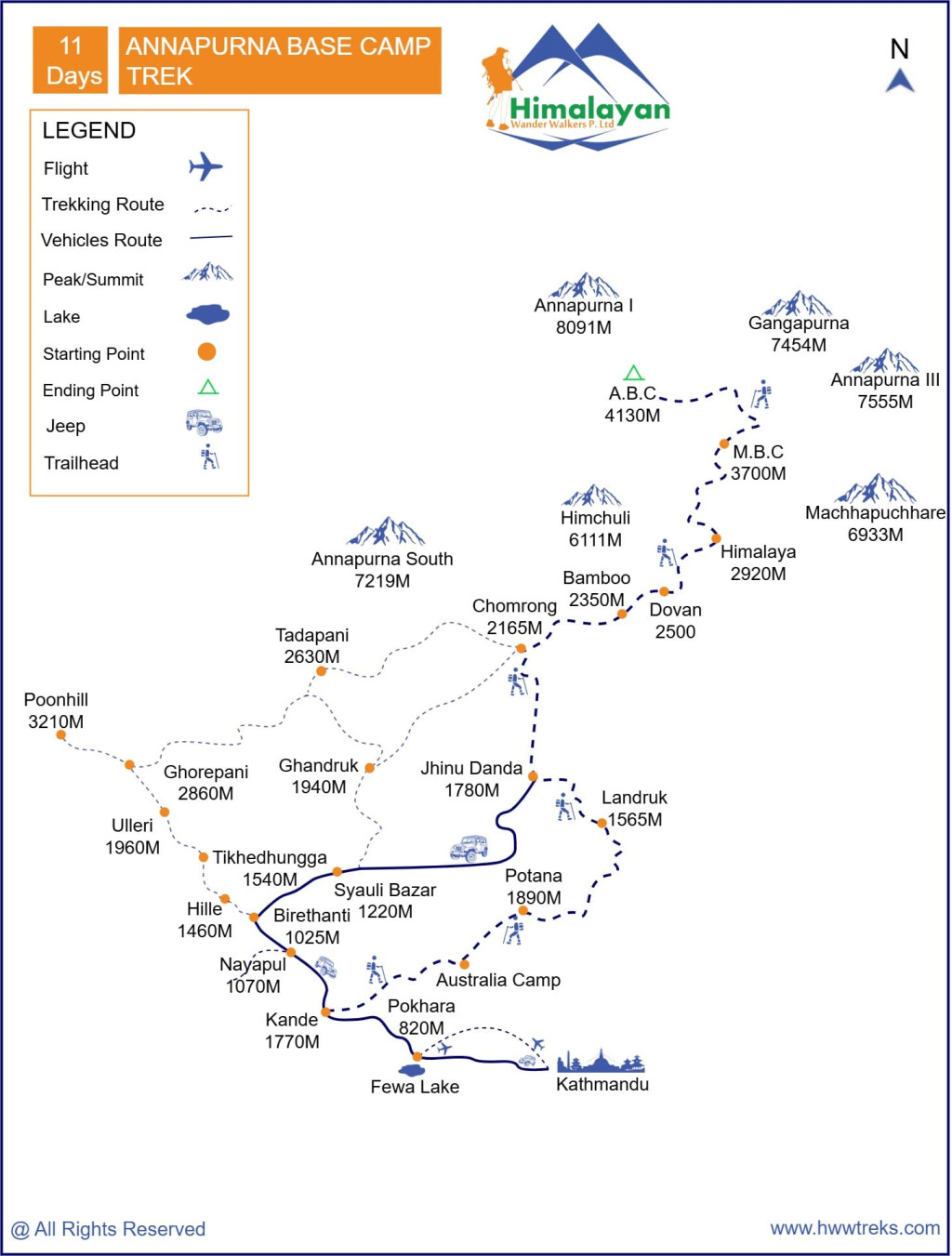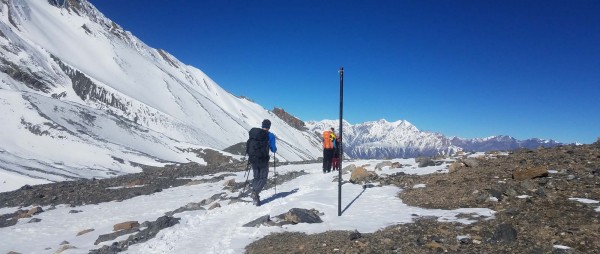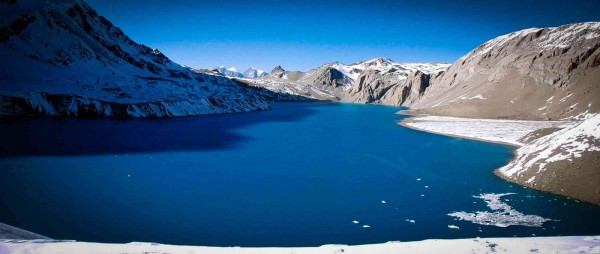Important Information
Region
Annapurna Region Treks
Duration
11 Days
Max Altitude 4120 meters
Best Season March, April, May and September, October, November
Activity Per Day
5-6 hours walk
Grade
Level 3
Group Size
2 - 12 people
Transportation Tourist Bus
“The Annapurna Base Camp (ABC) trek is the most tranquil and the best scenic base camp trek in the Himalayan world.”
Annapurna Base Camp is commonly known as ABC (4,130 m), but it is also called the Annapurna Sanctuary Trek (Annapurna Deuthali in Nepali). It is one of the most popular trekking areas in Nepal. The peak trekking season is swarming, making all available teahouses not enough for trekkers for their lodging. This trek offers fine close-up mountain views without the acclimatization problems like the Everest region. The trekking trail to spectacular ABC is completed in one week. Although it has some long steps ascents and descents, mainly on stone steps the trek will not be difficult as we move with the team enchanted by the natural beauty on the pathway. Following the Annapurna Base Camp trekking route gradually uphill, we get to enjoy panoramic views of Hiunchuli, Machhapurchre (Fishtail), and Annapurna South peaks.
The Annapurna Base Camp trek offers you outstanding 360-degree panoramic views of the Annapurna ranges. The trek is going to be more pleasing in the spring season, as Gurans (Rhododendron flower) will make the whole forest colorful with red, pink, and white colors. Nevertheless, it is possible to do the Annapurna Base Camp trek all year round.
In Annapurna Base Camp there are terrific views of the close-vertical south face of Annapurna I (the world's 10th highest mountain- 8091 meters) towering above the sanctuary to the northwest. The ascent of this face in 1970 by an expedition led by Chris Bonington remains one of the most remarkable climbs of an 8000-meter peak. Generally, morning is the best time for the views of the mountain. The mountains seen from ABC are Tharpu Chuli (tent peak 5663m), Singu Chuli peak (6501m), Hiunchuli (6441m), and South Annapurna (7219 m). Just behind the Paradise guest house, there is a memorial Chorten (Buddhist stone monument) built in memory of well-known climber Anatoli Boukrev from Kazakh who died in 1997 in an avalanche. That is the main viewpoint from where you will see prayer flags with different countries' flags attached to them. On the left side of the way to Chorten, you will see the shepherds' hut. Next to that, you will see a flock of sheep in the evening. When you follow a few minutes ahead of the shepherds' hut you will see another stoned Chorten which is built for the memory of three Korean climbers; Park Young Seok, Shin Dong-Min, and Kang Ki- Seok who lost contact with the base camp team on 18th October 2011. Three minutes beyond the Korean memorial Chorten, you have a wonderful sight of Annapurna glacier view.
If you are looking for a different itinerary than the itinerary here please Customize Your Trip
The highlight of the Annapurna Base Camp Trek
- 360-degree view of the Annapurna ranges including Annapurna I, Annapurna South, Hiunchuli, Machhapuchhere, Gangapurna, etc.
- Experiencing the typical cultural Gurung village of Ghandruk and scenic views with a close-up view of Annapurna South, Hiunchuli, and Fishtail.
- The trekking trail goes through a forest rich in flora and fauna.
Include
All airport pick-up & drop by private vehicle (international and domestic)
Annapurna Conservation Area Permit (ACAP) and Trekkers’ Information Management System (TIMS card)
English speaking, government licensed guide with all his salary, food, drinks, accommodation, transport and insurance
Twin/double sharing accommodation in the mountain during the trekking
Three meals a day; breakfast, lunch and dinner during the trek
First aid kit
Arrangement of emergency evacuation service (should have insurance for emergency evacuation and will be paid by your travel insurance company)
Trekking route maps
All necessary government taxes and service charges
Porter (For two person)
Exclude
Your Nepal visa fees and 2 passport size photos
All the International air fare from and to Kathmandu
All meals and accommodation in Kathmandu and Pokhara
Hot spring fee
Food and accommodations in case of early arrivals from the trek or late departures from airport
Your extra personal expenses during trek such as (laundry, baggage charge, phone calls, battery recharge, bar and beverage bill, boiled or bottle water, hot and cold shower, extra porter etc)
Tips for the trekking crew
Extra expenses due to flight delays, strikes, weather condition or any event out of our control
Route Map

Important Information
CHECKLISTS FOR ANNAPURNA BASE CAMP TREK
- Valid passport (valid for six months from the date of your trip)
- MasterCard, Visa Credit, and Debit Cards are accepted in Nepal. However, some cash is highly recommended.
- Mobile (if your cell phone is from CINGULAR USA or ATNT (USA) operators, then your cell phone will work in Nepal.)
- Clothing (Layered clothes, windproof and waterproof jackets, fleece pullovers, thermal base layers, hiking pants, shorts, headwear, footwear, and other items according to your needs)
- Personal Items and Toiletries (First-Aid Kit, Iodine tablets or a UV purifier to treat water, Sun Protection)
- Travel and Health Insurance
- Trekking gear and equipment(if you have your own trekking gear and equipment, such as trekking poles, sleeping bag, and shoes, then you can bring them; else you can rent them in Thamel, Kathmandu). Read more for trekking gears and peak climbing gears.
Guiding, Food, and Lodging
In Nepal, all trekking supplies - Teahouse trekking means staying and eating in local lodges. We stay in single rooms where possible, but often you will have to share. Rooms are basic, normally just a bed with a pillow, blankets. A few have electric lights and all have a spacious dining room-lounge. We eat at teahouses and, although the food is usually plentiful and delicious, the menu is not expensive. They offer a variety of potatoes, rice and noodle dishes, as well as soup and seasonal vegetables. Beers and local spirits are often available, but that will be at your own cost. A variety of cereals, bread, and egg dishes are generally available for breakfast. There are also snacks available such as basic biscuits, chocolate, and soft drinks and in some areas, you will find fresh fruit in season. It is normal to meet your porter in the teahouse where you will stay overnight. So, pack your necessary things in your own day pack.
DRESS CODE FOR VISITING MONASTERIES, AND TEMPLES IN NEPAL
- Shirt (either half or full sleeve)
- Full pants/long skirts
- Any type of shoes with socks
- No Hats, No Umbrella, No Slippers, No t-shirts, No short skirt, and No half-pants
- Photographs allowed in the courtyard only.
Note regarding itineraries
Although we generally adhere to the schedule, the itinerary is subject to change for numerous reasons beyond our control, including weather and terrain conditions, suitable campsite availability, and the group's general fitness level. It is important to understand that our trek is logistically complex and it is not unusual that adjustments be made. Our guide will orient you each evening to the following day's plan; their good judgment is the key to the long history of successful treks that Himalayan Wander Walkers has led till now. Please remember that our ability to make adjustments as needed helps to ensure that your trek is successful.
Frequently Asked Question
Yes, you can customize the Annapurna Base Camp Trek. We can adjust the itinerary based on your preferences, whether you want to shorten or lengthen the trek or add extra rest days. If you're interested in visiting specific villages or scenic spots along the way, we can tailor the route to suit those desires. Just let us know your preferences: “Customize Your Trip."
The trek is moderate to challenging, with steady ascents and high-altitude gains. It’s doable for most trekkers with a decent fitness level, with the highest altitude being the base camp at 4130 meters.
For the Annapurna Base Camp Trek, essential gear includes warm layers, a rain jacket, trekking boots, sunscreen, water bottles, a sleeping bag, a headlamp, and a first-aid kit. Don’t forget your passport and necessary permits.
While a guide isn’t mandatory, having one is much recommended and also can enhance your experience and help with navigation and safety. Porters help carry your gear but are optional.
You will need two permits: the Annapurna Conservation Area Permit (ACAP) and the TIMS (Trekkers' Information Management System) card, which can easily be obtained in Kathmandu from government-licensed trekking agencies.
Yes, Wi-Fi is available at most teahouses, but it can be slow. Mobile networks are available in most areas, but the signal may be weak in higher altitudes.
Yes, you can rent or buy most trekking gear in Kathmandu or Pokhara, often at affordable prices. Read more about trekking gear.
No questions found matching your search. Try different keywords or browse all questions above.
| {{type.min}} - {{type.max}} Pax {{type.name}} - {{type.desc}} | {{type.display_price}} per people |
Extra prices:
Let us help you decide Inquiry
You might also like

- 14 days
- Annapurna Region Treks
Annapurna Circuit Trek -Thorang La Pass
“Unlike most treks, Annapurna circuit classic is an ancient trade route which is rewarding and something you will always remember.” Annapurna circuit trek is the most diverse trekking route in Nepal where it connects with four different districts and two different zones....



